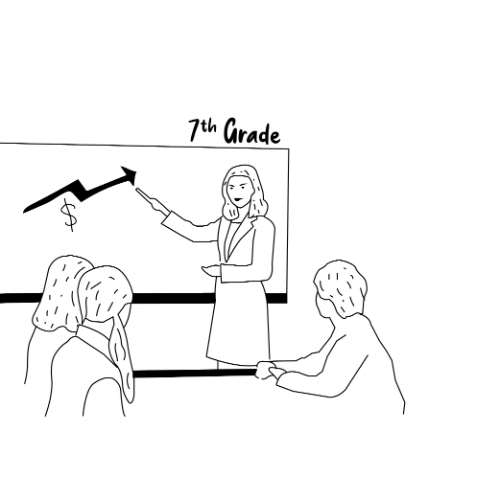As a teacher or homeschooler of 7th-grade students, you have a lot on your plate. These kids are in a time of transition, for many a challenging period somewhere between childhood and young adulthood. According to the World Book Learning Resources, 7th-graders should learn about topics like world trade and resources, looking at them through microeconomics, macroeconomics, personal finance, and economic foundations. While this is a lot to cover, there is help: head over to the 7th grade money lesson plans page to download all the 7th-grade resources you will need this year!
While your core lessons are the centerpiece when you teach them about money, it is essential they receive different instructional approaches. One surefire way to engage their attention is through games and activities. Using money exercises in the classroom can create a positive atmosphere where your 7th-graders will feel comfortable learning more about finances and be ready for their futures. Let’s look at some proven and practical money games ideal for your students.
Online Games and Apps
Your students probably know more about tech than their teachers, so why not use it to your advantage? They will love going online and playing money games that strengthen their financial skillset within a fun format. These activities are ideal for stepping up their money game and keeping them hooked on the economic principles you introduce in class.
Financial Football
Middle school students consistently enjoy video games, sports, and competition. This online game combines them into one fun-to-play yet educational app, ideal for 7th-grade learners. Visa and the NFL put together the app, joining the worlds of finance and football to make learning economic concepts exciting. Your students will enjoy joining a pro team, moving up the rankings, and gaining valuable money knowledge.
Balance Your Checking Account
As your students learn more about accounts, banking, and checks, you can synthesize these concepts together with this game. Kids are given a beginning balance, several credits and debits, and fees, and they need to balance their accounts correctly to move through the game. It is an excellent exercise in a real-life activity that all adults should know how to do, showing them how to enter data into a check register, categorize transactions, and more.
Charge!
Managing credit is one of the vital topics middle schoolers learn, and this game reinforces the pros and cons of using credit to buy products. Students go shopping for different things in this game, with various interest rates and terms on the purchase: some short-term and others stretching over long periods. They will soon see that sometimes credit is not the best option, as they end up paying much more than if they had bought the item outright.
Check It Out!
Your 7th-graders will enjoy playing around with the variables of this game, as they can adjust and choose how much to pay towards specific bills as if they lived independently. They get a monthly allowance and have to budget their way through the game, not overspending on expenses and staying within their means: an excellent skill for all adults to have and a good one to learn at a young age.
Determining Your Budget
This game is another budgeting activity, which is crucial for adolescents to begin thinking about and understanding. Students need to research various careers to see what salary they pay, plug those numbers into the game, find out how much bills will cost per month, and see if they can maintain their budgets.
Easy Budget Online
This website is a good tool for adults to input their financial information, but it also works well for 7th-graders to play around with to see how far their money would stretch. Your students will see that there are many costs associated with living on their own, while the site also guides them to the different ways they can invest and save money, helping to show kids the complex yet essential skills they will need later.
It All Adds Up
This useful game teaches kids the ins and outs of credit cards, including raising their credit scores, keeping their balances low, and how various charges and hidden fees can impact their finances. The goal is to purchase as many things as possible while maintaining your credit card payments and keeping your score intact, which will help your students as they mature and manage credit.
Plan Your Dream Prom
While your 7th-grade students may be a bit young to actually go to a prom, it’s never too early to plan the financial side of significant events like it. In this game, students input the different costs, such as what they will wear, how they will ride to the dance, and more, to see if they can afford the price or if they need to adjust some factors.
Rich Kid Smart Kid
This website has several resources and games divided by grade, letting your students search for games during their independent time and learn valuable skills. It also has resources for your kids to review what they have learned throughout their years in money education and brush up on essential skills through gameplay.
Sense and Dollars
Your students can learn all about money on this site by playing games or clicking on mini-lessons and topic reviews. The site breaks down its resources into earning, spending, and saving categories, providing a valuable independent study resource for your kids to expand on what they’ve learned.
Trade Ruler Game
One of the primary themes of 7th-grade money education is world trade, and this game fits nicely into that topic, as students participate in a global exchange to win. Students need to grow their wealth by strategically trading with other countries or islands, demonstrating that the world is interconnected today and that multiple sides can prosper thanks to global trade.
Online Resources and Hands-On Activities
Supplementary financial education for your 7th-graders can be more than just games. Many activities, including downloadable exercises and worksheets, will highlight economic strengths and good habits. Here are some great resources for your students.
It’s in the Budget!
Kids will enjoy this budgeting worksheet, as it presents realistic situations and asks them to devise creative solutions to improve their budget. Your students can complete this activity independently or with a partner and see how earning income and monthly expenses directly impact how much they can afford each month.
How Interesting!
Students study interest in this downloadable resource, seeing how various interest rates affect different purchases they may make in the future. It provides real examples of costs for unique items, and students need to calculate how much they will pay after a specific time period at certain interest rates.
When Prices Rise
Inflation is a significant factor in life’s expenses, and your 7th-grade students should be aware of how it can impact prices down the road. This activity has learners predicting future costs based on historical interest rates, so they can begin planning on how to save, which careers will pay off best, and how they may prioritize expenses in the years ahead.
Can You Handle the Risk?
Risk management is a topic that many 7th-grade educators bring into the curriculum, and this activity is a great way to break it down and supplement core instruction. It focuses on investment, specifically asset allocation, and students decide which portfolios are the safest and which are the riskiest. The ability to self-analyze risk in investments will do young students well.
Spread it Around!
This challenging activity pushes your students to understand the stock market, particularly the idea of diversification. Kids in this grade level learn the topic of investing, and it will benefit them greatly to see—at a young age—the importance of spreading out stocks, bonds, and mutual funds to minimize risk. Hopefully, your 7th-graders will start to develop good habits that they can put into effect as soon as they earn an income.
Buying a Home
This activity allows kids to see the many factors that go into major buying decisions, such as purchasing a car or home. In this exercise, students need to think deeply about what considerations affect their crucial choices as they plan to buy a home, and if renting may be a better option.
The Influence of Advertising
In the 7th-grade money education curriculum, the notions of incentives, persuasion, and advertising come up throughout the year. This worksheet walks kids through how advertising works and has them fill in answers as they go, encouraging them to think about what they have seen in ads and what strategies companies use.
Saving and Investing
This worksheet is a good review of several core topics you have taught or will teach in the 7th-grade year, including short-term and long-term goals, interest rates, and investing basics. Students fill out the sheet individually, in pairs, or in a center setup, working with others to perform mathematical calculations and real-life scenario questions.


